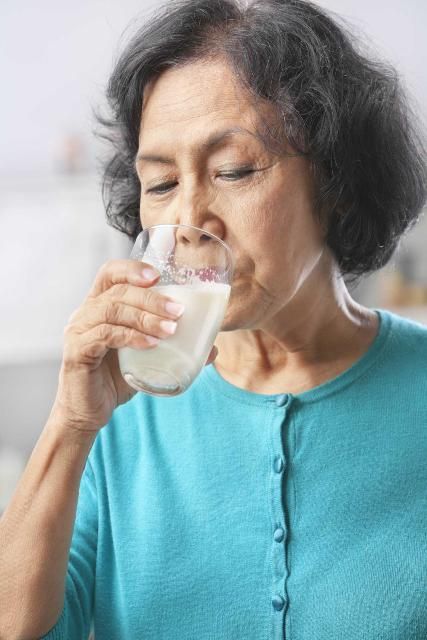Why do older adults develop malnutrition?
Many older adults are at risk of developing malnutrition – a lack of adequate nutrition to maintain health (Moreira et al. 2016). Poor appetite is strongly related to developing malnutrition (van der Pols-Vijlbrief et al. 2014). Problems with swallowing may also lead to lower food intake and risk of malnutrition (Mann, Heuberger, and Wong 2013). Older adults who care for themselves may have problems purchasing and transporting food to their homes and may have difficulties preparing nutritious meals. Taking many medications contributes to malnutrition risk, due to side effects such as nausea, dry mouth, and gastrointestinal complaints (Moreira et al. 2016). Malnutrition can also result from diseases or health conditions that cause problems with the digestion of food and absorption of nutrients.

Credit: Spotmatik/iStock/Thinkstock, © Spotmatik
Why are we concerned about malnutrition?
Malnutrition in older adults, particularly those in care homes, can lead to many serious health problems (Agarwal et al. 2016). The consequences of malnutrition include:
- infections
- pneumonia
- falls and fractures
- digestive disorders
- skin breakdown, pressure sores
- confusion, memory problems

Credit: Lisa F. Young/iStock/Thinkstock, © Lisa F. Young
Malnutrition in older adults may lead to poor quality of life and contribute to higher care needs, hospitalization, and increased health care costs. Improving nutrition in older adults may lead to:
- Briefer illnesses
- Fewer and shorter hospital stays
- Fewer complications
- Improved functional status
- More independent living
- Improved quality of life
What nutrients are most needed to prevent malnutrition?
Energy and Protein
When weight loss happens, total food intake and energy (calories) are inadequate. This leads to loss of body fat and muscle. Loss of muscle leads to weakness and mobility issues (Bollwein et al. 2013). Loss of body fat means there is less energy stored in the event of illness and less "padding" which may cause discomfort and an increased risk of pressure sores (Compher et al. 2007).
Older adults with higher protein intakes have a lower risk of becoming frail (Rahi et al. 2016). Foods high in protein, such as meat, poultry, and fish are recommended. However, some meats may be difficult to chew for those with dental issues or dry mouth. Meats, then, may need to be ground and moistened with gravies to encourage intake.
Dairy foods such as milk, yogurt, and cheese are recommended to improve protein and calorie intake (Iuliano, Woods, and Robbins 2013).

Credit: Jacek Chabraszewski/iStock/Thinkstock, © Jacek Chabraszewski

Credit: Rudyanto Wijaya/iStock/Thinkstock, © Rudyanto Wijaya
Eggs and meat alternates such as beans are also encouraged. These foods are good sources of protein and are usually easy to chew and swallow.
In addition to protein, added fat may be needed to increase calories, prevent further weight loss, and encourage weight gain if needed. Adding fats may improve the flavor of foods and may also ease swallowing.
Vitamins and Minerals
Older adults often have low intakes of many vitamins and minerals. For example, folate, magnesium, zinc, and Vitamins E, B6, B12, C, and thiamin may be low in older adults living in nursing homes (Lengyel, Whiting, and Zello 2008).
Older adults may need to take a vitamin and mineral supplement or consume nutritional beverages or pudding supplements with added vitamins and minerals to meet their needs.
What are the vitamin deficiencies of greatest concern?
Vitamin D
Most older adults have intakes of vitamin D below the recommended level (Amed et al 2021). Foods naturally rich in vitamin D are limited (fatty fish, egg yolks, and some mushrooms). Vitamin D is made in our skin following exposure to sunlight. However, this process decreases with aging and many older adults spend most of their time indoors. Public health warnings against sun exposure have also encouraged people to avoid the sun.
Vitamin D inadequacy occurs frequently in older adults, especially those that live in nursing homes (Rolland et al 2013). Low intakes of vitamin D are related to an increased risk of hip fractures (Wang et al 2020), as well as muscle weakness and pain (Charoenngam et al 2019). As diet alone cannot meet vitamin D requirements for older adults, supplements are required (Whiting and Calvo 2010).
Vitamin B12
Vitamin B12 deficiency is very common in older adults. This is a serious deficiency as it leads to anemia as well as depression and irreversible dementia (Sahu et al 2022).
B12 deficiency in older adults is often due to problems absorbing the vitamin B12 found naturally in foods such as fish, meat, eggs, and milk. Low dietary intake of B12, such as when a vegan diet is consumed without supplementation, also results in deficiency. Supplements providing B12 are often recommended for older adults.
What can caregivers do?
As a caregiver or family member of an older adult, there are several steps you can take to prevent malnutrition. If you notice weight loss or reduced food intake, try the following tips.
- Prepare meals high in protein, including foods such as meat, poultry, fish, dairy, eggs, and beans.
- If you notice difficulty chewing, try soft, moist foods and cut up/ground meat.
- Offer foods with added fats to increase caloric intake and enhance flavor.
- Offer nutritious snacks or nutritional supplements between meals.
Where can I get more information?
The UF/IFAS Extension Family and Consumer Sciences (FCS) agent at your local UF/IFAS Extension office may have more information and classes for you to attend. More information about UF/IFAS Extension can be found at https://sfyl.ifas.ufl.edu/find-your-local-office/. Also, a registered dietitian nutritionist (RDN) can provide reliable information to you.
References
Agarwal, E., S. Marshall, M. Miller, and E. Isenring. 2016. "Optimising nutrition in residential aged care: A narrative review." Maturitas 92:70–8. doi: 10.1016/j.maturitas.2016.06.013.
Ahmed, M., A. Praneet Ng, and M.R. L'Abbe. 2021. “Nutrient intakes of Canadian adults: results from the Canadian Community Health Survey (CCHS)-2015 Public Use Microdata File.” Am J Clin Nutr 114(3):1131-1140. doi: 10.1093/ajcn/nqab143.
Bollwein, J., D. Volkert, R. Diekmann, M. J. Kaiser, W. Uter, K. Vidal, C. C. Sieber, and J. M. Bauer. 2013. "Nutritional status according to the mini nutritional assessment (MNA(R)) and frailty in community dwelling older persons: a close relationship." J Nutr Health Aging 17 (4):351–6. doi: 10.1007/s12603-013-0009-8.
Charoenngam, N., A. Shirvani, and M.F. Holick. 2019. “Vitamin D for skeletal and non-skeletal health: What we should know.” J Clin Orthop Trauma 10(6):1082-1093. doi: 10.1016/j.jcot.2019.07.004. Epub 2019 Jul 13. PMID: 31708633; PMCID: PMC6834997.
Compher, C., B. P. Kinosian, S. J. Ratcliffe, and M. Baumgarten. 2007. "Obesity reduces the risk of pressure ulcers in elderly hospitalized patients." J Gerontol A Biol Sci Med Sci 62 (11):1310–2.
Dunne, J. L., and W. J. Dahl. 2007. "A novel solution is needed to correct low nutrient intakes in elderly long-term care residents." Nutr Rev 65 (3):135–8.
Iuliano, S., J. Woods, and J. Robbins. 2013. "Consuming two additional serves of dairy food a day significantly improves energy and nutrient intakes in ambulatory aged care residents: a feasibility study." J Nutr Health Aging 17 (6):509–13. doi: 10.1007/s12603-013-0025-8.
Lengyel, C. O., S. J. Whiting, and G. A. Zello. 2008. "Nutrient inadequacies among elderly residents of long-term care facilities." Can J Diet Pract Res 69 (2):82–8. doi: 10.3148/69.2.2008.82.
Mann, T., R. Heuberger, and H. Wong. 2013. "The association between chewing and swallowing difficulties and nutritional status in older adults." Aust Dent J 58 (2):200–6. doi: 10.1111/adj.12064.
Moreira, N. C., S. Krausch-Hofmann, C. Matthys, C. Vereecken, E. Vanhauwaert, A. Declercq, G. E. Bekkering, and J. Duyck. 2016. "Risk Factors for Malnutrition in Older Adults: A Systematic Review of the Literature Based on Longitudinal Data." Adv Nutr 7 (3):507–22. doi: 10.3945/an.115.011254.
Rahi, B., Z. Colombet, M. Gonzalez-Colaco Harmand, J. F. Dartigues, Y. Boirie, L. Letenneur, and C. Feart. 2016. "Higher Protein but Not Energy Intake Is Associated With a Lower Prevalence of Frailty Among Community-Dwelling Older Adults in the French Three-City Cohort." J Am Med Dir Assoc 17 (7):672.e7–672.e11. doi: 10.1016/j.jamda.2016.05.005.
Rasheed, S., and R. T. Woods. 2013. "Malnutrition and quality of life in older people: a systematic review and meta-analysis." Ageing Res Rev 12 (2):561–6. doi: 10.1016/j.arr.2012.11.003.
Rolland, Y., P. de Souto Barreto, G. Abellan Van Kan, C. Annweiler, O. Beauchet, H. Bischoff-Ferrari, G. Berrut, H. Blain, M. Bonnefoy, M. Cesari, G. Duque, M. Ferry, O. Guerin , P. Hanon, B. Lesourd, J. Morley, A. Raynaud-Simon, G. Ruault, J.C. Souberbielle, and B. Vellas; French Group of Geriatrics and NutritIon. 2013. “Vitamin D supplementation in older adults: searching for specific guidelines in nursing homes.” J Nutr Health Aging 17(4):402-12. doi: 10.1007/s12603-013-0007-x. PMID: 23538667.
van der Pols-Vijlbrief, R., H. A. Wijnhoven, L. A. Schaap, C. B. Terwee, and M. Visser. 2014. "Determinants of protein-energy malnutrition in community-dwelling older adults: a systematic review of observational studies." Ageing Res Rev 18:112–31. doi: 10.1016/j.arr.2014.09.001.
Wang, N., Y. Chen, J. Ji, J. Chang, S. Yu, and B. Yu. 2020. “The relationship between serum vitamin D and fracture risk in the elderly: a meta-analysis.” J Orthop Surg Res 27;15(1):81. doi: 10.1186/s13018-020-01603-y.
Whiting, S. J., and M. S. Calvo. 2010. "Correcting poor vitamin D status: do older adults need higher repletion doses of vitamin D3 than younger adults?" Mol Nutr Food Res 54 (8):1077–84. doi: 10.1002/mnfr.200900536.